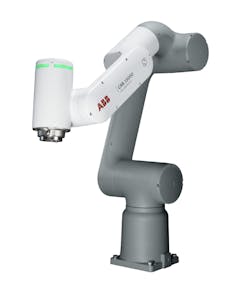Originally introduced to handle highly repetitive, low-weight tasks such as machine tending, assembly, and smaller packaging operations alongside humans, collaborative robots (cobots) have been increasing in capability over the past few years. These new capabilities enable cobots to perform a wider variety of tasks.
ABB’s new 6-axis GoFa CRB 15000 is one of these new cobots and is on display at PACK EXPO Las Vegas. It is designed to support the growing demand for cobots capable of handling heavier payloads. According to ABB, the GoFa CRB 15000 features a “class-leading reach of 950mm and speeds up to 2.2 meters per second” for a variety of packaging applications, including pick, pack-and-place, kitting, and product handling.
GoFa’s collaborative robot features include intelligent torque and position sensors in each of its six joints/axes. ABB says these specially designed joints “eliminate the risk of injury to human workers by sensing any unexpected contact between the cobot’s arm and a human to bring the robot arm to a stop within milliseconds.”
Programming GoFa is done via ABB’s new Wizard programming software, which employs “simple graphical blocks” to ease the programming process for personnel who are not robot specialists. The blocks represent actions such as “move to location,” “pick up an object,” and “repeat task” to make the programming process more intuitive.
ABB points out that every ABB cobot installation includes a start-up package that provides ABB Ability condition monitoring and diagnostics as well as a support hotline free for the first six months to access ABB’s expert technical assistance.
Leaders relevant to this article:


